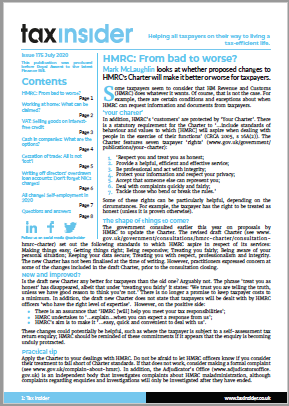Below is a sample article from our monthly tax saving 'Tax Insider' newsletter. In this article Tony Granger points out some investments can reduce Inheritance Tax
Granger points out some investments can reduce Inheritance Tax
As part of your 14-day free trial, you can get access to over 880 more tax saving strategies. Try Tax Insider Today.
Key points:
- IHT is chargeable on death at 40% on dutiable assets after the nil rate band of £325,000.
- Investments can be sheltered from IHT, allowing more for heirs.
What is Inheritance Tax?
In 2012/13 the Government raised £3.147 billion in inheritance taxes, an increase of 8% over the previous tax year. Inheritance Tax (IHT) is payable on chargeable estates at 40%.
There are many ways of reducing IHT. For example, you can broadly make gifts to third parties and survive for 7 years (‘potentially exempt transfers’ (PETs)); give away income in excess of your needs (immediate exemption), make annually exempt gifts of up to £3,000 per annum, make small gifts of £250 per annum to any person, or gifts to charities and political parties, gifts in contemplation of marriage (e.g. £5,000 per parent); make gifts of any amount to a UK domiciled spouse or civil partner, and make use of other exemptions and allowances.
Not everyone wishes to give assets away during their lifetime and would rather their assets worked for them, providing income or capital growth. Some investments can reduce Inheritance Tax; others can become exempt from IHT. The following is a selection:
Enterprise Investment Scheme (EIS) investments
Investments made into an an Enterprise Investment Scheme (EIS) qualifying unquoted company or AIM stock will not be liable to Inheritance Tax after being held for at least two years under the business property relief (BPR) rules.
The clock runs from the time the investment was made. After two years, the value and growth on the investment shares fall out of your estate for IHT purposes. The EIS investment can be replaced with another EIS investment within certain time limits, and the EIS ‘clock’ continues to run. EIS portfolio planning is often used for the elderly, although it is higher risk. Dividends payable are taxable. Losses on shares are generally deductible as loss reliefs.
The maximum EIS qualifying investment is £1 million per person in 2013/14. You can set up your own EIS qualifying company and obtain the Inheritance Tax reliefs.
ISAs holding EIS Shares
Previously, ISA investments would be subject to IHT on death, as they are not holding exempt assets. However, ISAs may, from 5 August 2013, now hold EIS qualifying shares, and the EIS part will qualify for Inheritance Tax relief under the BPR rules. The maximum ISA investment is £11,520 in 2013/14.
Discounted gift trust investments
Discounted gift trust investments provide for an immediate exemption from IHT (i.e. reflecting a ‘discount’ fora retained income stream on a portion of the investment), with the balance of the investment falling out of the taxable estate once the settlor survives 7 years (as a Potentially Exempt Transfer). The investment is made in trust and provides an income stream to the settlor, which on death has no value.
The balance (including the growth on it) passes to beneficiaries and may also be IInheritance Tax free if the settlor survives 7 years.
Gift and loan trusts
A useful way to create some flexibility is to use a ‘gift and loan trust’. On death, the value of any loan outstanding falls into your estate. However, the value of any trust investment made and the growth on it will generally fall outside your estate for IHT purposes.
Pensions
Pension funds passing on death to a spouse or civil partner incur no Inheritance Tax.
Life Assurance
If a life policy is written into trust, the proceeds on death normally escape IHT.
Woodlands
The ownership of woodlands is treated as a business for IHT purposes, and can attract 100% Business Property Relief.
Membership of Lloyds
This is treated as a business for IHT purposes, and can attract 100% Business Property Relief.
Practical Inheritance Tax Tip :
If the objective is to save IHT, analyse all investments and determine which ones can be IHT sheltered. You could save thousands of pounds! Independent financial advice should be obtained on the investment where necessary. Professional advice should also be sought on the IHT implications.
Below is a sample article from our monthly tax saving 'Tax Insider' newsletter. In this article Tony Granger points out some investments can reduce Inheritance Tax
Granger points out some investments can reduce Inheritance Tax
As part of your 14-day free trial, you can get access to over 880 more tax saving strategies. Try Tax Insider Today.
Key points:
- IHT is chargeable on death at 40% on dutiable assets after the nil rate band of £325,000.
- Investments can be sheltered from IHT, allowing more for heirs.
What is Inheritance Tax?
In 2012/13 the Government raised £3.147 billion in inheritance taxes, an
... Shared from Tax Insider: Investments That Reduce Inheritance Tax
 Granger points out some investments can reduce Inheritance Tax
Granger points out some investments can reduce Inheritance Tax


